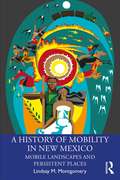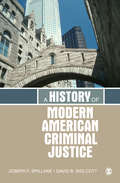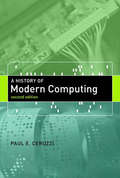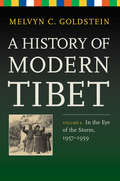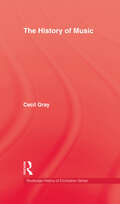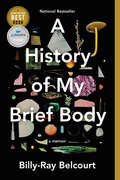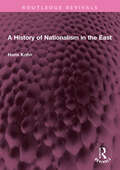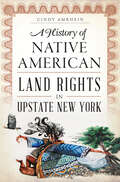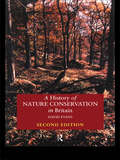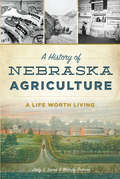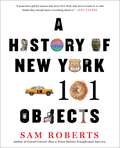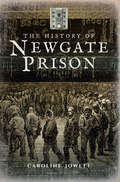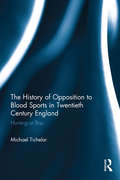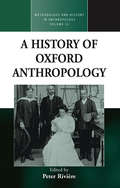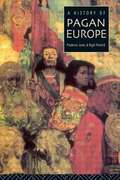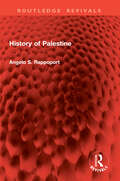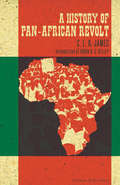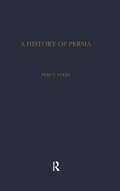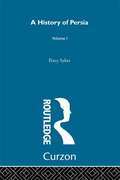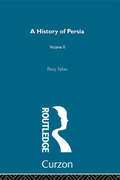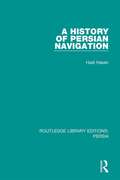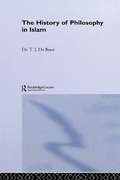- Table View
- List View
A History of Mobility in New Mexico: Mobile Landscapes and Persistent Places
by Lindsay M. MontgomeryA History of Mobility in New Mexico uses the often-enigmatic chipped stone assemblages of the Taos Plateau to chart patterns of historical mobility in northern New Mexico. Drawing on evidence of spatial patterning and geochemical analyses of stone tools across archaeological landscapes, the book examines the distinctive mobile modalities of different human communities, documenting evolving logics of mobility—residential, logistical, pastoral, and settler colonial. In particular, it focuses on the diversity of ways that Indigenous peoples have used and moved across the Plateau landscape from deep time into the present. The analysis of Indigenous movement patterns is grounded in critical Indigenous philosophy, which applies core principles within Indigenous thought to the archaeological record in order to challenge conventional understandings of occupation, use, and abandonment. Providing an Indigenizing approach to archaeological research and new evidence for the long-term use of specific landscape features, A History of Mobility in New Mexico presents an innovative approach to human-environment interaction for readers and scholars of North American history.
A History of Modern American Criminal Justice
by Joseph F. Spillane Dr David B. WolcottIn A History of Modern Criminal Justice, authors Joseph Spillane and David Wolcott focus on the modern aspects of the subject, from 1900 to the present. A unique thematic rather than a chronological approach sets this book apart from the competition, with chapters organized around themes such as policing, courts, due process, and prison and punishment. Making connections between history and contemporary criminal justice systems, structures and processes, A History of Modern Criminal Justice offers students the latest in historical scholarship, made relevant to their needs as future practitioners in the field. This book is appropriate for any course on the history of criminal justice.
A History of Modern Computing, second edition (History of Computing)
by Paul E. CeruzziFrom the first digital computer to the dot-com crash—a story of individuals, institutions, and the forces that led to a series of dramatic transformations.This engaging history covers modern computing from the development of the first electronic digital computer through the dot-com crash. The author concentrates on five key moments of transition: the transformation of the computer in the late 1940s from a specialized scientific instrument to a commercial product; the emergence of small systems in the late 1960s; the beginning of personal computing in the 1970s; the spread of networking after 1985; and, in a chapter written for this edition, the period 1995-2001. The new material focuses on the Microsoft antitrust suit, the rise and fall of the dot-coms, and the advent of open source software, particularly Linux. Within the chronological narrative, the book traces several overlapping threads: the evolution of the computer's internal design; the effect of economic trends and the Cold War; the long-term role of IBM as a player and as a target for upstart entrepreneurs; the growth of software from a hidden element to a major character in the story of computing; and the recurring issue of the place of information and computing in a democratic society. The focus is on the United States (though Europe and Japan enter the story at crucial points), on computing per se rather than on applications such as artificial intelligence, and on systems that were sold commercially and installed in quantities.
A History of Modern Tibet, Volume 4: In the Eye of the Storm, 1957-1959
by Melvyn C. GoldsteinIt is not possible to understand contemporary politics between China and the Dalai Lama without understanding what happened in the 1950s, especially the events that occurred in 1957–59. The fourth volume of Melvyn C. Goldstein's History of Modern Tibet series, In the Eye of the Storm, provides new perspectives on Sino-Tibetan history during the period leading to the Tibetan Uprising of 1959. The volume also reassesses issues that have been widely misunderstood as well as stereotypes and misrepresentations in the popular realm and in academic literature (such as in Mao’s policies on Tibet). Volume 4 draws on important new Chinese government documents, published and unpublished memoirs, new biographies, and a large corpus of in-depth, specially collected political interviews to reexamine the events that produced the March 10th uprising and the demise of Tibet’s famous Buddhist civilization. The result is a heavily documented analysis that presents a nuanced and balanced account of the principal players and their policies during the critical final two years of Sino-Tibetan relations under the Seventeen-Point Agreement of 1951.
A History of Mongolian Shamanism
by Dalai Chuluunii Erdene-Otgon DalaiThis book discusses the evolution of Mongolian shamanism from the distant past to the collapse of great empires such as the Yuan Dynasty in the fourteenth century, drawing on archeological findings and historical resources like the Mongolian Secret History. Further, it introduces readers to the cultural and ideological differences between Mongolian shamanists, who believe in the Eternal Blue Sky, and modern Mongols, who follow Buddhist teachings. In closing, the authors put forward the idea that Mongolian shamanism could have helped build great empires, emphasizing, e.g., shamanism’s influence on Mongolian culture and literature in the Middle Ages.
History Of Music: Music Book Index (The\history Of Civilization Ser.)
by CecilFirst published in 2005. Routledge is an imprint of Taylor & Francis, an informa company.
A History of My Brief Body
by Billy-Ray BelcourtThe youngest ever winner of the Griffin Prize mines his own personal history to reconcile the world he was born into with the world that could be.Billy-Ray Belcourt's debut memoir opens with a tender letter to his kokum and memories of his early life in the hamlet of Joussard, Alberta, and on the Driftpile First Nation. From there, it expands to encompass the big and broken world around him, in all its complexity and contradictions: a legacy of colonial violence and the joy that flourishes in spite of it, first loves and first loves lost, sexual exploration and intimacy, and the act of writing as a survival instinct and a way to grieve. What emerges is not only a profound meditation on memory, gender, anger, shame, and ecstasy, but also the outline of a way forward. With startling honesty, and in a voice distinctly and assuredly his own, Belcourt situates his life experiences within a constellation of seminal queer texts, among which this book is sure to earn its place. Eye-opening, intensely emotional, and excessively quotable, A History of My Brief Body demonstrates over and over again the power of words to both devastate and console us.
A History of Nationalism in the East (Routledge Revivals)
by Hans KohnFirst published in 1929, A History of Nationalism in the East brings together in one truly fascinating volume a mass of information hitherto scattered and partly unavailable. Hans Kohn sums up the general situation in his Introduction. He tells us that the World War I produced three great communities of interest, distinct and, to some extent, mutually antagonistic. The first was that of the continent of Europe, barring Russia, which was faced with the necessity for the gradual breaking down of national boundaries, for political, financial, and economic reasons. The second was that of the Anglo-Saxon people, the United States, Great Britain, Canada, Australia, and South Africa. This had to face Soviet Russia on the one hand, and the Oriental, the third, community of interests on the other. Here he sketches suggestively the development of the nationalist movement in Islam, India, Egypt, Turkey, Arabia, and Persia. The language used is a reflection of its era and no offence is meant by the Publishers to any reader by this republication. This book will be of interest to students of history, political science, international relations, and geography.
A History of Native American Land Rights in Upstate New York
by Cindy AmrheinA complex and troubled history defines the borders of upstate New York beyond the physical boundaries of its rivers and lakes. The United States and the state were often deceptive in their territory negotiations with the Iroquois Six Nations. Amidst the growing quest for more land among settlers and then fledgling Americans, the Indian nations attempted to maintain their autonomy. Yet state land continued to encroach the Six Nations. Local historian Cindy Amrhein takes a close and critical view of these transactions. Evidence of dubious deals, bribes, faulty surveys and coerced signatures may help explain why many of the Nations now feel they were cheated out of their territory.
A History of Nature Conservation in Britain
by David EvansOur attitudes towards `nature' and the countryside are fickle. The conservation movement, despite enjoying its highest membership ever, has achieved only limited success over the last one hundred years of campaigning. Can conservationists now shake off their insular, disunited and negative image so as to gain the influence that the size of their movement warrants? A History of Nature Conservation in Britain traces the rise of the conservation movement from its beginnings in Victorian coffee houses to today's societies with their membership numbering in the millions. The first complete history of the British, and oldest, branch of the movement, David Evans's book offers invaluable insights into the campaigns for countryside protection and access, from battles against the use of pesticides, against pollution and genetic engineering through to legislation for the protection of our wildlife and the freedom to walk the mountains. The 2nd Edition has been fully revised and updated. Topical issues are considered afresh; and new chapters reflect the rapid changes throughout the 1990s both in social attitudes, conservation practices, legislation, funding and within conservation organizations themselves. In the light of recent developments, Evans also looks at some difficult choices to be made in years ahead and asks how the conservation movement will fare on the new global stage.
History of Nebraska Agriculture, A: A Life Worth Living (American Heritage)
by Jody L. DobsonOnce known as the “Great American Desert,” Nebraska’s plains and native grasslands today make it a domestic leader in producing food, feed and fuel. From Omaha to Ogallala, Nebraska’s founding farmers, ranchers and agribusiness leaders endured hardships while fostering kinships that have lasted generations. While many continued on the trails leading west, others from around the world stayed, seeking a home and land to cultivate. American Doorstop Project co-founders and authors Jody L. Lamp and Melody Dobson celebrate the state’s forgotten and untold agricultural history, highlighting more than a century and a half of agriculture industry, inventions and innovations in the Cornhusker State.
A History of New York in 101 Objects
by Sam Roberts“Delightfully surprising….A portable virtual museum…an entertaining stroll through the history of one of the world’s great cities” (Kirkus Reviews), told through 101 distinctive objects that span the history of New York, almost all reproduced in luscious, full color.Inspired by A History of the World in 100 Objects, Sam Roberts of The New York Times chose fifty objects that embody the narrative of New York for a feature article in the paper. Many more suggestions came from readers, and so Roberts has expanded the list to 101. Here are just a few of what this keepsake volume offers: -The Flushing Remonstrance, a 1657 petition for religious freedom that was a precursor to the First Amendment to the Constitution. -Beads from the African Burial Ground, 1700s. Slavery was legal in New York until 1827, although many free blacks lived in the city. The African Burial Ground closed in 1792 and was only recently rediscovered. -The bagel, early 1900s. The quintessential and undisputed New York food (excepting perhaps the pizza). -The Automat vending machine, 1912. Put a nickel in the slot and get a cup of coffee or a piece of pie. It was the early twentieth century version of fast food. -The “I Love NY” logo designed by Milton Glaser in 1977 for a campaign to increase tourism. Along with Saul Steinberg’s famous New Yorker cover depicting a New Yorker’s view of the world, it was perhaps the most famous and most frequently reproduced graphic symbol of the time. Unique, sometimes whimsical, always important, A History of New York in 101 Objects is a beautiful chronicle of the remarkable history of the Big Apple. “The story [Sam Roberts] is telling is that of New York, and he nails it” (Daily News, New York).
The History of Newgate Prison
by Caroline JowettA history of the iconic London prison, featuring insights on daily life, the evolution of prison systems, and famous inmates.As the place where prisoners, male and female, awaited trial, execution, or transportation Newgate was Britain’s most feared gaol for over 700 years. It probably best known today from the novels of Charles Dickens including Barnaby Rudge and Great Expectations.But there is much is more to Newgate than nineteenth century notoriety. In the seventeenth century it saw the exploits of legendary escaper and thief Jack Sheppard. Among its most famous inmates were author Daniel Defoe who was imprisoned there for seditious libel, playwright Ben Jonson for murder, and the Captain Kidd for piracy.This book takes you from the gaol’s 12th century beginnings to its final closure in 1904 and looks at daily life, developments in the treatment of prisoners from the use of torture to penal reform as well as major events in its history.Praise for The History of Newgate Prison“An amazing, entertaining and informative book!” —Books Monthly“This is a highly readable and accessible account, not only of the iconic institution, but also of the history of crime and punishment. It is packed full of evocative detail and is essential reading for all those interested in crime history.” —Who Do You Think You Are? magazine
The History of Opposition to Blood Sports in Twentieth Century England: Hunting at Bay
by Michael TichelarAn interdisciplinary social history, this book examines the major pressures and influences that brought about the remarkable growth of opposition to hunting in twentieth century England. With public opinion consistently deciding from the middle of the century onward that hunting mammals for sport was cruel and unacceptable, it would appear that the controversy over hunting has all but been decided, though hunting yet remains ‘at bay’. Based on a range of cultural, social, literary and political sources drawn from a variety of academic disciplines, including history, sociology, geography, psychology and anthropology, The History of Opposition to Blood Sports in Twentieth Century England accounts for the change in our relationship with animals that occurred in the course of the twentieth century, shedding light on the manner in which this resulted in the growth in opposition to hunting and other blood sports. With evidence comprising a mixture of primary and secondary historical sources, together with documentary films, opinion polls, Mass Observation records, political party archives, and the findings of sociologists, political scientists, anthropologists and geographers, this book will appeal to scholars and students across the social sciences and historians with an interest in human–animal relations.
History of Our World: People, Places, and Ideas (Volume 1 of the Ancient World)
by Henry BillingsLife for the earliest people was very different from life today. What if the things you use every day suddenly disappeared? Imagine your life without houses, cars, clothes, or books. How would you find food? How would you stay safe? These are questions that the earliest people faced. This unit tells how the earliest people answered those questions. To us, it might not seem like a big step to put a seed in the ground or a wheel on a cart. But for early people, each discovery was a huge step forward.
A History Of Oxford Anthropology
by Peter RiviereInformative as well as entertaining, this volume offers many interesting facets of the first hundred years of anthropology at Oxford University.
A History of Pagan Europe
by Prudence Jones Nigel PennickThe book is the definitive study of the indigenous religions of Europe and their practices, beliefs and customs. The authors divide Europe into five broad cultural areas and trace the expression and development of Pagan religion in each of them from earliest times to present day. From the serpent goddesses of ancient Crete to modern nature worship and the restoration of the indigenous religions of Eastern Europe, the wide-ranging book offers a provocative new perspective of European history.
History of Palestine (Routledge Revivals)
by Angelo S. RappoportFirst published in 1931, History of Palestine is the dramatic picture of the Holy Land to which Jews returned after many centuries. The author has written the history of Palestine of 4000 years with the mind of the scholar and the heart of the religious mystic. Divided into three parts—pre-Israelite Palestine; Palestine, the promised land of the Hebrews; and Palestine, the holy land of Christendom, this book will appeal to students and researchers of history and general readers interested in the topic.
A History of Pan-African Revolt (The Charles H. Kerr Library)
by C. L. R. James Robin D. G. KelleyOriginally published in England in 1938 and expanded in 1969, this work remains the classic account of global Black resistance. This concise, accessible history of revolts by African peoples worldwide explores the wide range of methods used by Africans to resist oppression and the negative effects of imperialism and colonization as viewed in the 20th century. Written from a radical perspective with a substantial new introduction that contextualizes the work in the ferment of the times, A History of Pan-African Revolt is essential to understanding liberation movements in Africa and the diaspora and continues to reveal new insights, lessons, and visions to successive generations.
History of Persia (Routledge Library Editions)
by Sir Percy SykesThis is a facsimile of a classic history first published by Macmillan in 1915 and issued in two further editions by Routledge and Kegan Paul. Sir Percy Sykes was an explorer, consul, soldier and a spy who lived and travelled in Persia over a period of twenty-five years. This two-volume collection provides a comprehensive history of Persia from Alexander the Great, through British, French and Russian colonialism, to the early twentieth century oil industry.With a new introduction by Sykes' biographer, Antony Wynn, this comprehensive history provides essential background reading to students and academics of Persia.
A History Of Persia (Volume 1)
by Sir Percy SykesThis is a facsimile of a classic history first published by Macmillan in 1915 and issued in two further editions by Routledge and Kegan Paul. Sir Percy Sykes was an explorer, consul, soldier and a spy who lived and travelled in Persia over a period of twenty-five years. This two-volume collection provides a comprehensive history of Persia from Alexander the Great, through British, French and Russian colonialism, to the early twentieth century oil industry. With a new introduction by Sykes' biographer, Antony Wynn, this comprehensive history provides essential background reading to students and academics of Persia.
A History Of Persia (Volume 2)
by Sir Percy SykesThis is a facsimile of a classic history first published by Macmillan in 1915 and issued in two further editions by Routledge and Kegan Paul. Sir Percy Sykes was an explorer, consul, soldier and a spy who lived and travelled in Persia over a period of twenty-five years. This two-volume collection provides a comprehensive history of Persia from Alexander the Great, through British, French and Russian colonialism, to the early twentieth century oil industry. With a new introduction by Sykes' biographer, Antony Wynn, this comprehensive history provides essential background reading to students and academics of Persia.
A History of Persian Navigation (Routledge Library Editions: Persia #3)
by Hadi HasanThis book, first published in 1928, is based on Chinese, Persian and Arabic sources, and provides the first scholarly account of the history of Persian maritime exploration.
History Of Philosophy In Islam
by J T DenBoerThis is a pre-1923 historical reproduction that was curated for quality. Quality assurance was conducted on each of these books in an attempt to remove books with imperfections introduced by the digitization process. Though we have made best efforts - the books may have occasional errors that do not impede the reading experience. We believe this work is culturally important and have elected to bring the book back into print as part of our continuing commitment to the preservation of printed works worldwide.
